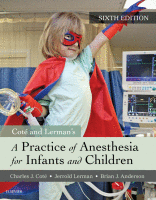Physical Address
304 North Cardinal St.
Dorchester Center, MA 02124

THE PHARMACOKINETICS AND PHARMACODYNAMICS of most medications in children, especially neonates, differ from those in adults. Children exhibit different pharmacokinetics (PK) and pharmacodynamics (PD) from adults because of their immature renal and hepatic function, different body composition, altered protein binding,…

U.S. PRESIDENT WILLIAM CLINTON, when announcing the relative completion of the Human Genome Project in July 2000, stated “With this profound new knowledge, humankind is on the verge of gaining immense new power to heal. Genome science will have a…

CLINICIANS MUST TAKE SERIOUSLY “the experience, perspective, and power of children.” Clinicians should treat every child and family with the grace and consideration with which they would want their own child and family treated. Taking the experience of children seriously…

Preparation of Children for Anesthesia Fasting Infants and children are fasted before sedation and anesthesia to minimize the risk of pulmonary aspiration of gastric contents. In a fasted child, only the basal secretions of gastric juice should be present in…

INTEREST IN CHILDREN'S PERIOPERATIVE behavior has increased dramatically over the past 20 years. Specifically, the recognition of the importance of developmental factors in perioperative research has created a dramatic growth of investigation in this area. In this chapter, we discuss…

GROWTH IS A COMPLEX succession of phenomena that starts with the fusion of two cells and matures by 9 months into a complex organism known as a fetus. This phenomenally complex process not only produces a human being, it also…

IN THIS CHAPTER, WE outline the basis of our collective practice of pediatric anesthesia. These basic principles of practice can be applied regardless of the circumstances; they provide the foundation for safe anesthesia. Preoperative Evaluation and Management Parents and Child…